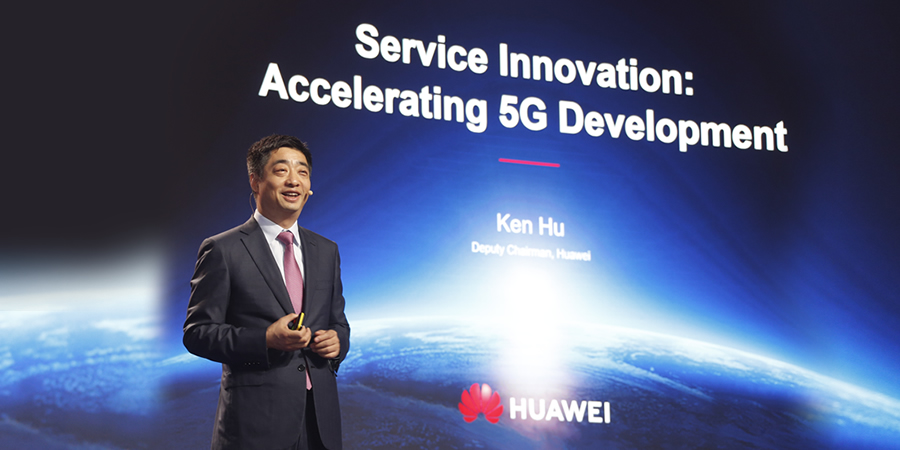At MWC Shanghai 2019, Huawei Deputy Chair Ken Hu gave an update on Huawei's progress in 5G deployment, sharing concrete examples of how service innovation and cross-industry collaboration are driving the next phase of growth in 5G.
“The networks themselves are the foundation of everything, but the future of 5G development will rely heavily on services. 5G-enabled service innovation will help us push network performance to the next level, and help operators get greater returns on their 5G investment,” he said.
“To date, we have signed 50 commercial contracts for 5G around the world, and we have shipped 150,000 5G base stations. This is far more than our industry peers. Many operators around the world, including those from Europe, the Middle East, and Asia Pacific, are racing to deploy their 5G networks.
“Congratulations are in order for China, which officially issued its 5G licenses earlier this month. This marks the beginning of 5G commercialization in the world's largest mobile communications market. I believe China will help set a great example for the rest of the world, and provide useful insight for deployment in other regions,” he added.
Huawei Deputy Chairman argued that many operators are willing to choose Huawei for 5G because of its long term investment.
“We often say innovation is a marathon. You need to be fast, of course, but in it for the long run. There are three unique things about Huawei's investment in 5G innovation.
“First, we invested early. We started 5G research as early as 2009. That's back when 4G was just starting to see commercial deployment. Second, we invested heavily, and continue to do so. Over the past ten years, we have invested $4 billion dollars in 5G.Third, we invest deeply. That's what sets us apart from our competitors. When we began 5G research, there were no standards to speak of. We had to basically start from scratch – we couldn't jump into product development right away. Products are only the results you see at the tail end of a very long process. So in the beginning we focused on standards development and basic research in chips, materials and algorithms.”
Huawei holds today more than 2,500 standard essential patents for 5G, which is roughly 20% of all 5G patents in the world. During the third phase of 5G field trials organized by IMT-2020, Huawei’s solutions outperformed its competitors, ranking No.1 across many key indicators.
“But innovation isn't just about technology. Part of our success is our focus on making 5G easier to operate, more affordable, and simpler to deploy,” he explained.
“Our 5G base stations outperform our 4G base stations by a factor of 20. And they are lighter and smaller on top of that. This significantly reduces deployment costs for our customers. Now, all you need is two people, and they can install a Huawei 5G base station in only 2 hours. That's half the time it takes for 4G.”
Ken Hu then talked about how 5G will change the world and the greatest value will be in vertical industries. Successful 5G applications are in the media and in the power industry, like grid protection, drone inspections, and smart metering.
Moreover, 5G can help solve problems in mines fields. With 5G networks and modules, we can enable driverless mining trucks. Cost-wise, this saves roughly one million RMB per year per driver. It also greatly increases efficiency, enabling the trucks to speed up from 10km/h to about 35km/h. Most importantly, because the trucks are driverless, the drivers aren't subjected to dangerous working conditions. In terms of costs, efficiency, and safety, 5G can provide a ton of value in the mining industry.
5G will also pay a pivotal role in the digitization of all industries. “Right now China is in the process of evolving towards automated, digital, and AI-driven industrial development. And 5G arrived just in time to help.”
He added, “5G can provide much greater bandwidth and lower latency than traditional wireless connections, and can also support different applications with dedicated network slices. This allows 5G to meet a wide range of industrial needs, and lays the foundation for a more fully automated, intelligent future.
“At the same time, as more and more industries embrace intelligence, we will see much greater demand for technologies like cloud, AI, big data, and edge computing. With the support of 5G, these technologies will be able to support far more industrial applications than ever before – and much more efficiently, too. 5G will help unleash the true power of cloud, AI, and edge computing. It will also help these technologies become more pervasive in industrial settings. Moving forward, 5G will gradually converge with all of these technologies and further accelerate the digitization process.”
He concluded, “June 6th was a huge milestone. Now that China has issued its 5G licenses, 2019 is officially the year of 5G. As a Chinese company, and as a leader in 5G, we are super excited and eager to do our part. 5G is here. We will put our shoulders to the wheel and work with our partners to drive greater collaboration. Together, we can use the power of 5G to help all industries go digital.”











